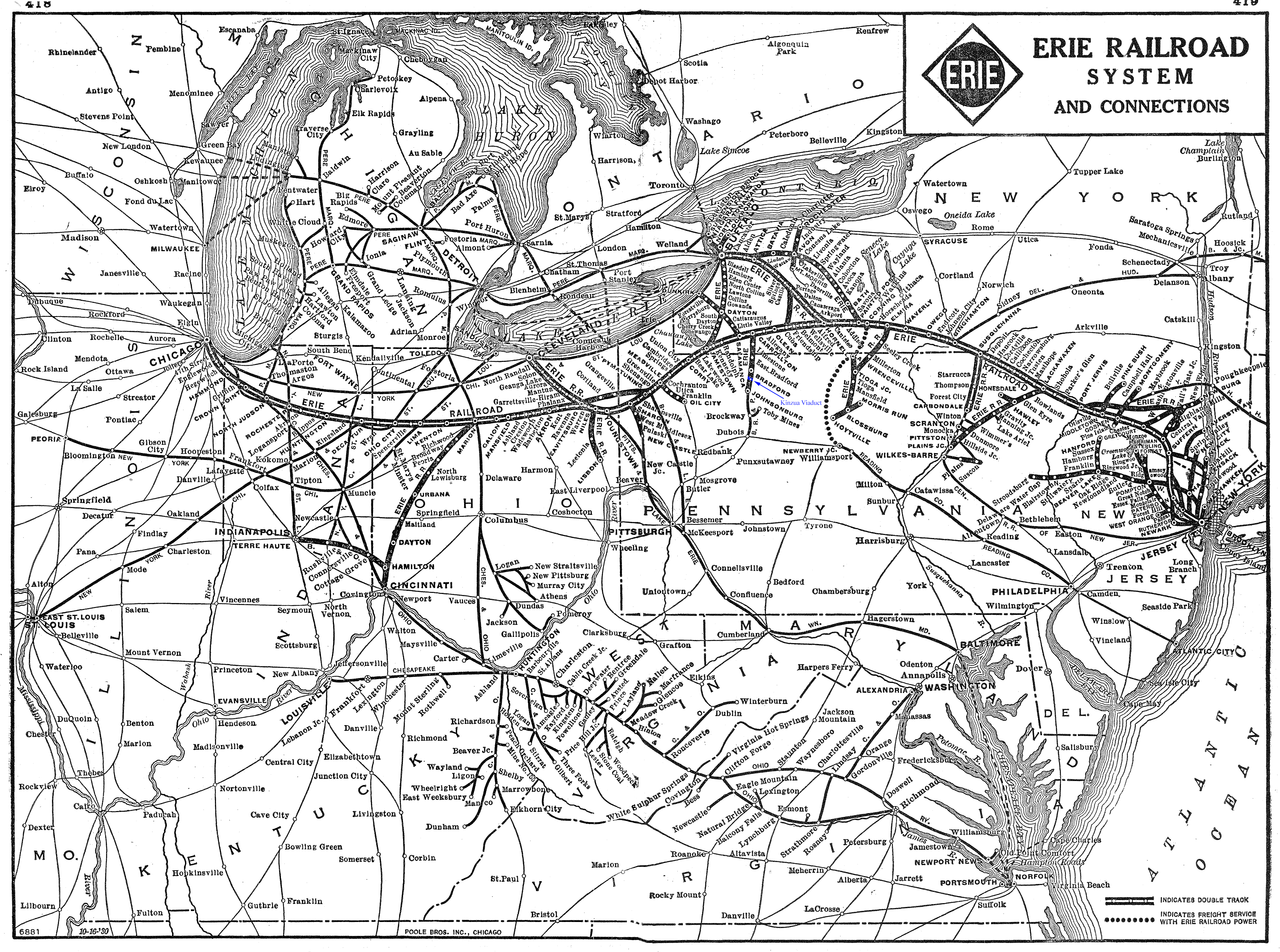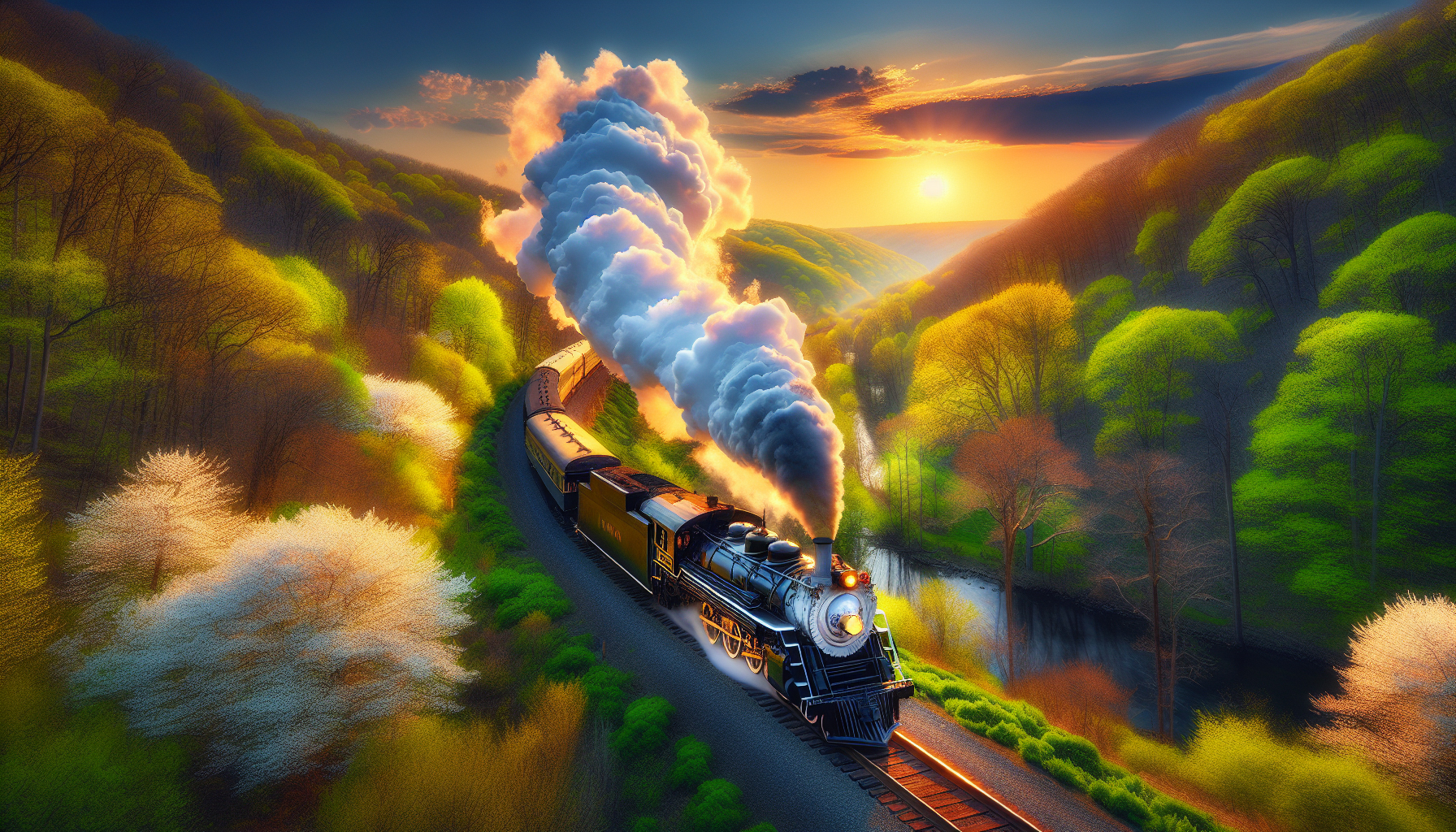Kinzua Viaduct Bridge (PA): Map, History, Trains
Last revised: August 24, 2024
By: Adam Burns
The Kinzua Viaduct, also known as the Kinzua Bridge, was a railroad trestle that spanned Kinzua Creek in McKean County in the U.S. state of Pennsylvania.
The bridge was originally built from iron in 1882 and was billed as the "Eighth Wonder of the World", holding the record as the tallest railroad bridge in the world for two years. In 1900, the bridge was dismantled and simultaneously rebuilt out of steel to allow it to accommodate heavier trains.
It stayed in commercial service until 1959 and was sold to the Pennsylvania state government in 1963, becoming a centerpiece of a state park. Restoration of the bridge began in 2002, but before it was finished, a tornado struck the bridge in 2003, causing a large portion of the bridge to collapse. Corroded anchor bolts holding the bridge to its foundations failed, contributing to the collapse.
Photos
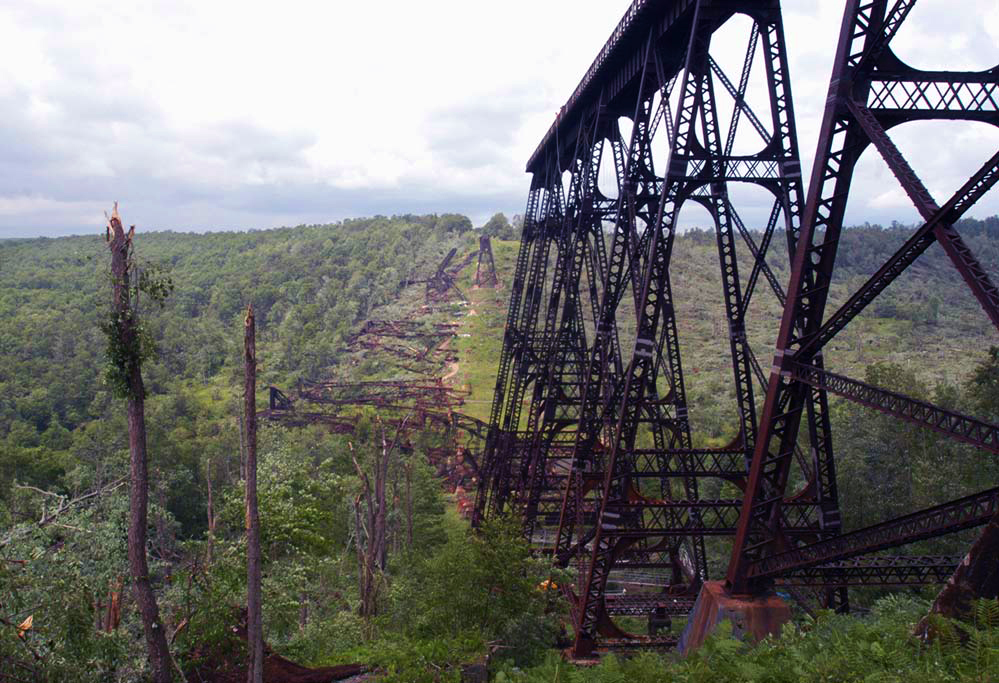 A present-day view of Kinzua Viaduct following the destruction caused by an F-1 tornado on July 21, 2003.
A present-day view of Kinzua Viaduct following the destruction caused by an F-1 tornado on July 21, 2003.Overview
The Kinzua Bridge, also known as the Kinzua Viaduct, was a large and foreboding iron structure, which spanned Pennsylvania's Kinzua Valley. It was an impressive feat of engineering rising from the valley floor as it reached out to connect the neighboring hills.
The original bridge was completed in the 1880s and built by a predecessor of the Erie Railway in the hopes of reaching the rich coal fields south of the Pennsylvania/New York state line.
The property later became a subdivision of the growing Erie system in the late 19th century, which continued to use it until the 1950s. It was eventually acquired by the state of Pennsylvania, which saw it as a potential tourist attraction.
For more than 30 years the rail line, and surrounding grounds, were, indeed, quite popular with tourists. Sadly, a strong thunderstorm and tornado in the summer of 2003 destroyed much of the central span. What remains today has been converted into a state park and walking bridge.
History
The history of the Kinzua Bridge begins with the New York, Lake Erie & Western Railroad an immediate predecessor of the modern Erie Railroad.
In the early 1880s, with the railroad stretching from New York City to Buffalo and northwestern Pennsylvania, officials of the company were interested in extending a branch to tap the coal fields around Johnsonburg, Pennsylvania in Elk County.
To do so, however, would require circuitous route hugging valleys and hills . It was ultimately decided a branch would divert southward from Carrollton, New York (just southeast of Salamanca) and connect Johnsonburg with spurs extending from that point to reach nearby mines.
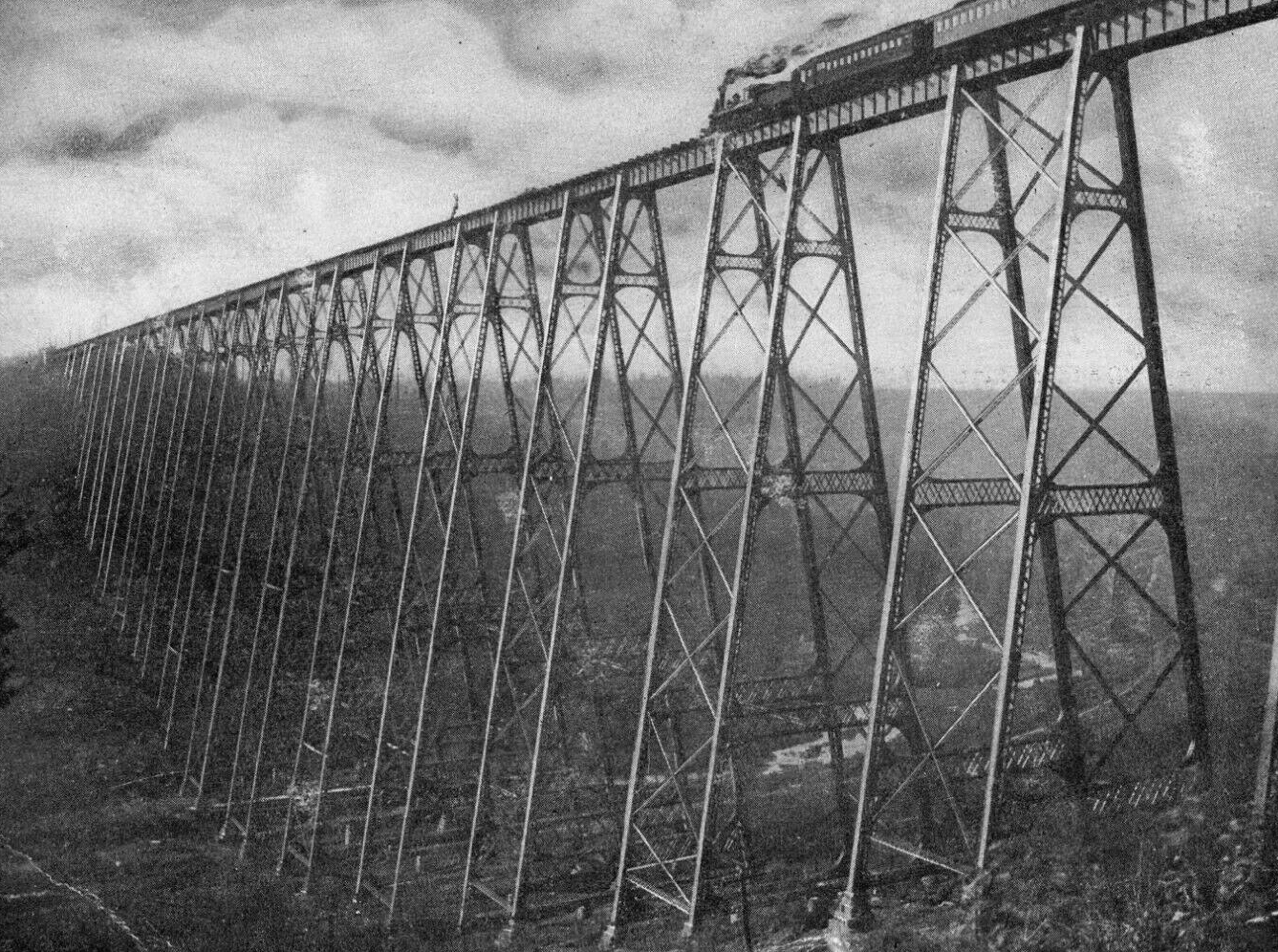 An early postcard of Kinzua Viaduct showing a train crossing the 2,100-foot structure. It loomed some 301.5 feet above the valley floor.
An early postcard of Kinzua Viaduct showing a train crossing the 2,100-foot structure. It loomed some 301.5 feet above the valley floor.In an attempt to make line not only shorter but also with fewer curves and grades, NYLE&W president Thomas Kane decided to span the Kinzua Valley via massive bridge.
Perhaps the most surprising aspect of this plan was merely the speed in which it happened. The idea was first discussed in 1882 and work began immediately on May 10th that year. By August 29th, just 94 days later, the massive structure had been finished!
Octave Chanute
The viaduct was designed by Octave Chanute and contract work was carried out by the Phoenix Iron Works of Phoenixville, Pennsylvania which used straight wrought iron in the construction process. The foundation was sandstone, acquired from local quarries, and required 110 piers to span the valley.
Map (1930)
These piers supported 20 towers, with the tallest standing 301 feet from the valley floor (to the top of rail). Overall, the viaduct was 2,052 feet long and billed as the "Eighth Wonder of the World" when it opened.
The structure was also the tallest in the world at the time but it soon lost this title in 1884. Interestingly, while it was meant mostly as a freight line it quickly drew large crowds of tourists hoping to experience a trip high above the valley and the breathtaking views available. As a novel marketing idea the railroad began hosting regular excursions over the line.
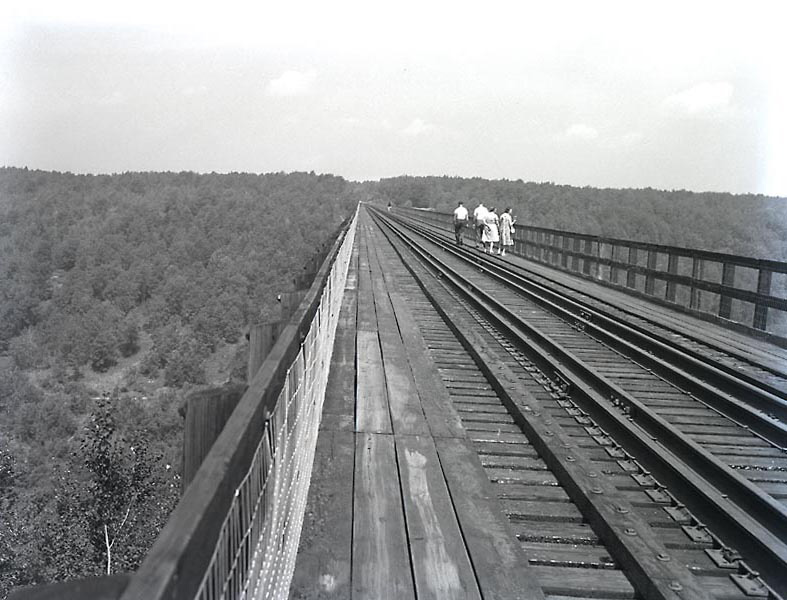 The Kinzua Viaduct in the 1960s. At this time the structure was often not in regular service. Instead, it was known as the Kinzua Bridge State Park from 1963 until 1987.
The Kinzua Viaduct in the 1960s. At this time the structure was often not in regular service. Instead, it was known as the Kinzua Bridge State Park from 1963 until 1987.Operation
In 1893 the New York, Lake Erie & Western fell into bankruptcy which prompted yet another reorganization. The company emerged in 1895 as the Erie Railroad.
At the turn of the century it was concluded that the bridge needed a major overhaul with stronger materials to allow for heavier trains.
In late May, 1900 worked commenced to take down the old structure and simultaneously replace it with new towers and deck plate girders. The new Kinzua Bridge was designed by C.R. Grimm and constructed from much more durable steel fabricated by the Elmira Bridge Company. Overall, the bridge appeared quite similar to the original save for its more rigid look.
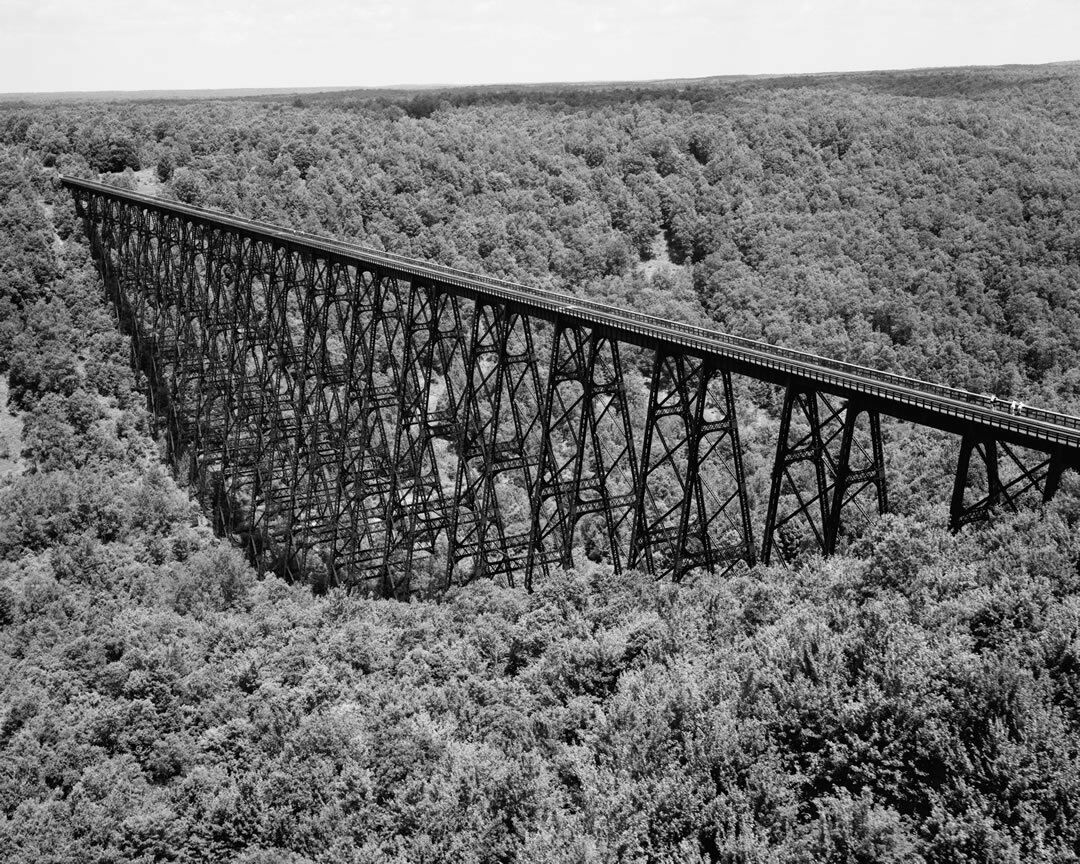 An aerial view of Kinzua Viaduct, circa 1971. Ironically, for 24 years (1963-1987) the entirely intact structure was also used a foot bridge, part of the Kinzua Bridge State Park.
An aerial view of Kinzua Viaduct, circa 1971. Ironically, for 24 years (1963-1987) the entirely intact structure was also used a foot bridge, part of the Kinzua Bridge State Park.By September 25th the rail line was reopened to traffic and could more than accommodate loaded coal trains and the heaviest steam locomotives of that time. The bridge remained in use for the next 50 years until the coal mines around Johnsonsburg played out.
On June 21, 1959 the Erie ran its last scheduled train over the branch and subsequently sold the line to the Kovalchick Salvage Company of Pennsylvania.
Excursions
Wishing to preserve the structure, the company resold the viaduct to the state, which created the Kinzua Bridge State Park on August 12, 1963. The route, however, remained dormant for nearly 25 years until 1987.
That year, on July 31st, tourist trains would again operate over the bridge when the Knox & Kane Railroad purchased a short section of the line for public excursions
The K&K dated back to 1982 as a short line operating about 65 miles of former Baltimore & Ohio trackage between Knox and Mt. Jewett, Pennsylvania (ex-Buffalo, Rochester & Pittsburgh). Its new addition continued northeast for about 5 miles to reach the bridge.
Just as had occurred in its early days, thousands rode across the viaduct annually to experience the magnificent sights high above the Kinzua Valley. These trips continued until 2002 when engineers decided that the bridge required major structural work for continued operation.
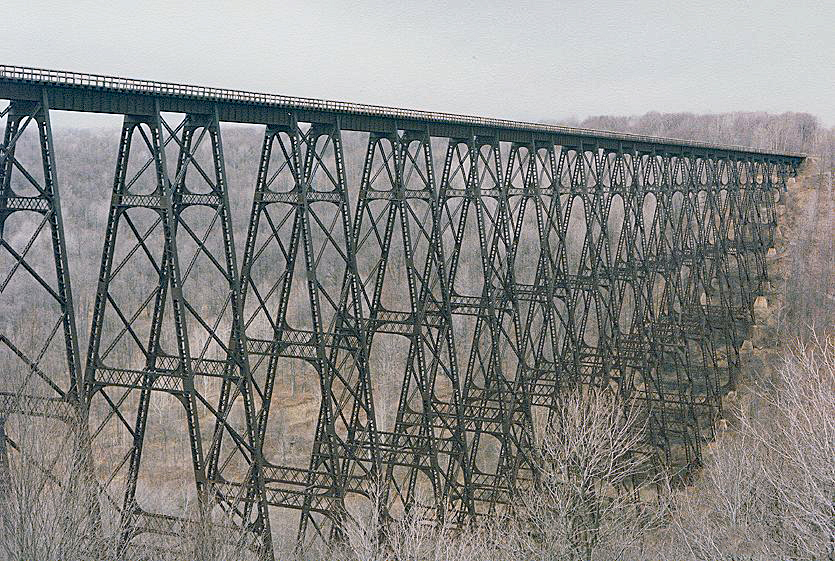 This newer photograph shows the viaduct as it appeared on February 20, 1983 which was then dormant and not in use although under state ownership. Doug Kroll photo.
This newer photograph shows the viaduct as it appeared on February 20, 1983 which was then dormant and not in use although under state ownership. Doug Kroll photo.Tornado Destruction (July 21, 2003)
This was funded by the state but unfortunately, as work had commenced a devastating severe thunderstorm hit the region on July 21, 2003 spawning an F1 tornado, which destroyed many of the central columns. With a price tag estimated at $45 million it was decided to simply repair the remaining approaches and turn them into a walking trail at the park.
With the loss of the bridge the Knox & Kane saw an immediate decline in ridership, ultimately resulting in the railroad suspending service. In 2006 the K&K ended all operations with its equipment and trackage sold by the same company that had previously owned the bridge, the Kovalchick Corporation.
Legacy
The destruction and subsequent reconstruction of Kinzua Viaduct not only speak about the power of nature but also the resilience of humanity.
Even in its partly destroyed state, the Viaduct generates significant local tourism revenue, with the Kinzua Bridge State Park attracting tens of thousands of visitors annually.
While the New York, Lake Erie, and Western Railway no longer exists, its contribution to the area's industrial history lives on through the Kinzua Viaduct.
The Kinzua Viaduct remains a testament to human mechanical genius and displays a unique perspective on the interaction between man and nature.
The Kinzua Bridge State Park enriches the Viaduct's lore, providing educational resources, branded merchandise, and hosting an annual Fall Festival.
Today, visitors still flock to what's left of the Kinzua Viaduct, captivated by its historical significance, architectural grandeur, and awe-inspiring setting.
In conclusion, whether one views the Kinzua Viaduct as a symbol of man's ambition to tame nature or as a symbol of nature's ultimate authority over man's creations, it's undeniable that this bridge has ingrained itself deep into local, national, and international history.
Contents
Recent Articles
-
Massachusetts Mother's Day Train Rides: A Complete Guide
May 04, 25 03:37 PM
There are a few locations in Massachusetts to enjoy a scenic train ride although only one offers an event themed towards Mom, the Cape Cod Central Railroad. -
Maryland Mother's Day Train Rides: A Complete Guide
May 04, 25 09:12 AM
If you are interested in a train ride tailored just to mom, check out the Walkersville Southern Railroad in Walkersville. -
Florida Mother's Day Train Rides: A Complete Guide
May 04, 25 09:11 AM
The popular Seminole Gulf Railway dinner train experience in Fort Myers offers a special Mother's Day excursion each year.
